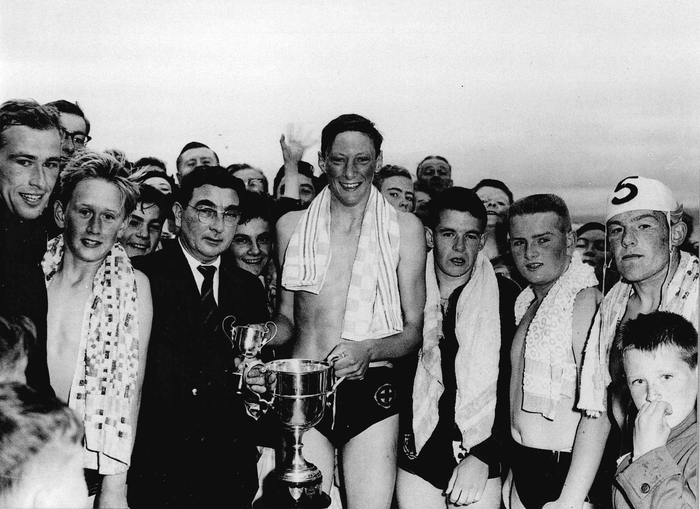Swimming is the self-propulsion of a person through water as a form of recreation, exercise or survival. It has numerous health benefits and is good for all ages and all levels of fitness. It is among the top public recreational activities. One can swim in the sea, the lake or river.
People have always swam in Salthill and the area has also been attracting tourists for some 200 years now. Some came unprepared and there were several instances in Victorian times where day trippers came without thinking of togs but could not resist the temptation to have a dip in the sea in the nude, scandalising walkers along the coast road.
It is hard to believe today that for a major part of the last century, there was no mixed bathing allowed in Salthill. It was a men-only zone in Blackrock and the Ladies beach was confined to women and children. The so-called family resort in fact divided families. Bishop Browne met a lady in a bikini on the Prom and gave her a lecture – You cannot appear in public dressed like that etc. When he finished his rant she simply said “Which bit would you like me to remove first”.
Competitive swimming really began in Galway in 1930 with the formation of two swimming clubs – Blackrock and Galway. All swimming activities for both of these clubs took place in the open sea at Salthill – lessons, training sessions, swimming galas, water safety competitions etc. Conditions were generally primitive for competitive events until 1971, when Leisureland opened with an indoor swimming pool.

If you grew up in or near Salthill, you probably spent most of your time either at ‘the Ladies’ or at Blackrock. Our first photograph (courtesy of Éamonn Ashe ) shows just such a group taken in 1950. They are, back row; Richard Walsh, the canal; Seán Walshe, the Stella Maris Hotel; Christy O’Connor, O’Connor’s Bar; Seán Ashe, Salthill; Tom Walshe, Stella Maris Hotel. In front are Padraig Walshe, Stella Maris Hotel; Bernard ‘Tiny’ Jackson, Shantalla; Michael ‘Skipper’ Donoghue, Salthill; Éamonn Ashe, Salthill; Tony O’Connor, O’Connor’s Pub.
One of the main swimming events of the year, since it was first raced in 1933, is the Prom Swim. It used to be run at the end of the summer and heralded the end of the swimming season. There were usually a number of these – men’s races, women’s races, club races, open races, but whichever one it was, it was tough. One had to compete against waves, swells, currents, jellyfish, the cold and exhaustion. It was a real endurance test initially taking place from Blackrock to Palmer’s Rock, then from Blackrock to Seapoint and occasionally from the reef to Palmer’s Rock.
The earliest of the cups for the race is the Toft Cup which was presented by Abby Toft for the first Prom Swim for amateur men swimmers in Connacht. It was organised in 1933 and was won by Eamonn Hartmann. Dessie Fitzpatrick was the victor in 1934, Eamonn Hartmann again in 1935, Jimmy Cranny in 1936 and Michael Molloy in 1937 and 1938.

Our second photograph was taken after the 1958 race and shows Claude Toft presenting the trophy to Michael Brennan from Taylors Hill. Claude offered Michael free gambling in his casino for the night. Also in the photograph are, from left, Pat Broderick, Jim Cradock, Brendan Watson, Billy Fitzgerald and Mickey Broderick.
Since then, there has been an enormous change in swimming patterns in Salthill, significant numbers of people swim all the year round and in all kinds of weathers, you can see people training for the prom swim for long periods before the race. There were, over the years, a number of failed attempts to swim the bay and land in Salthill, now they have the annual Frances Thornton Bay swim which has become increasingly popular and raises a lot of money for Cancer Care West.
The first official lifeguard in Salthill was Hugh Deeney and he covered the stretch from Blackrock to Palmer’s Rock. He was followed by Christy Dooley who had the job for about five years. They were employed by the Salthill Development Association. Today, that situation has also changed and now there are several lifeguards along the coast.
Swimming is a lot more popular today, sometimes looking at Blackrock is like looking at a busy anthill. But still, the old rules apply, we must treat the water with respect and also have respect for other swimmers, listen to the advice of the Irish Water Safety Association and read the lifeguard’s flag which tells you what conditions for swimming are.

